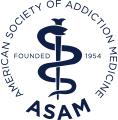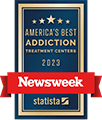Understanding Bipolar Disorder
Learn About Bipolar Disorder
Bipolar disorders are a group of mental illnesses that can lead to extreme turmoil within an individual’s life. Of these disorders, the most frequently recognized are bipolar I disorder, bipolar II disorder, and cyclothymic disorder. Each of these disorders, described by the Diagnostic and Statistical Manual of Mental Disorder (DSM-5), are explained below:
Bipolar I disorder is the most severe form of bipolar disorder, as the disturbances in mood that are indicative of this disorder will bring about significant impairment in an individual’s ability to function regularly. To receive a bipolar I diagnosis, an individual must have gone through at least one manic episode, which is either followed or preceded by hypomanic or major depressive episodes. Mood changes in those with bipolar I can be severe, changing quickly from euphoria to anger to depression.
Bipolar II disorder occurs when a major depressive episode and at least one hypomanic episode occurs. Those with bipolar II will go through disturbances in their functionality, however, they will not experience the same severity in impairment as those who battle the symptoms of bipolar I.
Cyclothymic disorder happens when an individual has symptoms of both hypomania and depression, however those symptoms are not severe enough to be considered a full episode of depression, mania, or hypomania. The American Psychiatric Association (APA) states that the premier feature of cyclothymic disorder (or cyclothymia) is continual changes in mood that encompass the symptoms of hypomania and depression.
While any form of bipolar disorder can bring on a great deal of upset for those who are afflicted, the challenges that individuals with this disorder must deal with can be increased if they are also struggling with a drug and/or alcohol addiction. A co-occurring substance use disorder may not only just aggravate existing symptoms of bipolar, but it can also bring on a new round of additional symptoms too. Additionally, the physical wellbeing of individuals in this situation can be put at significant risk. Luckily, there are available care options that can treat those who are struggling with bipolar disorder. By engaging in appropriate care, healthy, happy, and productive lives can be obtained.
Statistics
Statistics of Bipolar Disorder
Within the United States, the APA reports that roughly 0.6% of the population struggles with bipolar I disorder. Bipolar II disorder, on the other hand, impacts 0.8% of the population, while the lifetime prevalence of cyclothymic disorder is approximated to be between 0.1% and 0.4%.
Causes & Risk Factors
Causes & Risk Factors of Substance Abuse
The causes and risks factors connected to bipolar disorders are further explained below:
Genetic: The genetic background of an individual can be the most prominent cause for his or her onset of bipolar disorder. If an individual has a history of family members who struggle with this disorder, he or she is at an increased risk for also sharing the same experience. Regarding cyclothymic disorder, a family history of major depressive disorder can increase an individual’s likelihood of being diagnosed with this disorder. The APA states that genetic factors can also give information in regards to when an individual will begin seeing an onset of symptoms.
Environmental: An individual’s environment can play a major role in the onset of bipolar I disorder when there is a genetic predisposition present. The APA reports that bipolar I disorder is much more common in high-income countries than in low-income countries. In addition, they also state that those who are divorced, separated, or widowed have a higher potential for struggling with bipolar I than those who are not married or have never been married. However, the link between the two is not specifically defined just yet.
Risk Factors:
- Being widowed, divorced, or separated
- Having a family history of bipolar I, bipolar II, cyclothymic disorder, or major depressive disorder
- Living in a more developed country
- Abusing drugs and/or alcohol can cause the onset of symptoms when one possesses a genetic predisposition for the disorder
Signs & Symptoms
Signs & Symptoms of Bipolar Disorder
The signs and symptoms that individuals with bipolar disorders will exhibit will vary from person to person depending on the type of bipolar disorder that is occurring. Additionally, signs and symptoms will also be dependent on if an individual is going through an episode of hypomania, depression, or mania. Manic episodes only happen in those with bipolar I disorder, so if these symptoms are present, this diagnosis would be correct. Some examples of signs and symptoms that could occur during these types of episodes can include:
Manic episode: According to the DSM-5, manic episodes occur when individuals go through a period of elevated, extensive, or irritable mood that would otherwise be looked at as abnormal in nature. This mood lasts for at least one week, and symptoms will present themselves for the majority of the day almost every day. Manic episodes disrupt mood in a way that is so significant that individuals are often left impaired in their functionality. Signs of a manic episode are as follows:
- Participating in activities that have the potential to elicit detrimental consequences, such as going on major spending sprees or engaging in risky sexual behavior
- Euphoric or excessively cheerful mood
- Spending an increased amount of time in goal-directed activity
- Decreased need for sleep
- Psychomotor agitation
- Experiencing a flight of ideas
- Inflated self-esteem or sense of grandiosity
- Racing thoughts
- High level of distractibility
- Excessively talkative
Hypomanic episode: A hypomanic episode can be similar to manic episodes, however, they are not as severe and also do not last nearly as long. The symptoms of a hypomanic episode are present for a minimum of four consecutive days and occur for the majority of those days. These symptoms are obvious to others, however, they do not cause the individual to become functionally impaired as a result. Signs of a hypomanic episode can include:
- Participating in high-risk behaviors
- Heightened self-esteem or false sense of grandiosity
- Experiencing a flight of ideas and/or racing thoughts
- Becoming easily distracted
- Talking excessively
- Lacking a need for sleep
Major depressive episode: When individuals are battling a major depressive episode, they will have at least five symptoms within a two-week-long period and will show a change in their typical pattern of functioning. The symptoms of a major depressive episode can lead to functional impairment and upset that is viewed as clinically significant and can impact an individual’s life in a negative manner. The APA states that signs of a major depressive episode can include:
- Experiencing recurrent thoughts of death
- Suffering from a depressed mood most of the day, nearly every day
- Struggling to make decisions
- Feelings of worthlessness
- Diminished ability to concentrate
- Experiencing excessive and/or inappropriate guilt
- Fatigue or extreme loss of energy
- No longer demonstrating an interest in things that were once found pleasurable
- Psychomotor agitation or retardation
- No longer engaging in activities that one once enjoyed
- Noticeable change in appetite and subsequent weight loss or weight gain
- Struggling with insomnia or hypersomnia nearly every day
Effects
Effects of Bipolar Disorder
When individuals are battling bipolar disorders and do not obtain the appropriate treatments, they are more likely to go through a number of damaging effects. Some of these effects can include:
- Suffering from suicidal thoughts or engaging in suicidal behaviors
- Occupational struggles, which can lead to job loss and subsequent financial struggles
- Engaging in self-harming behaviors
- Financial turmoil as a result of spending excessive amounts of money during manic or hypomanic episodes
- Beginning to abuse drugs and/or alcohol
- Disturbances within interpersonal relationships
- Worsening of symptoms
- Familial strife
- Cognitive impairments
- Marital discord
Co-Occurring Disorders
Bipolar & Co-Occurring Disorders
According to the APA, co-occurring mental disorders are very common amongst those who battle bipolar disorders. Co-occurring substance use disorders specifically are linked to being especially prominent in those who have this type of mental health condition. Some examples of the many co-occurring conditions are separated by three forms of bipolar disorder and are explained through the following:
Bipolar II disorder: Anxiety disorders, such as social anxiety disorder, specific phobia, and panic disorder occur within nearly three-fourths of those who struggle with bipolar I. Other disorders known to co-occur with bipolar I can include:
- Other substance use disorders
- Intermittent explosive disorder (IED)
- Alcohol use disorder
- Oppositional defiant disorder (ODD)
- Attention-deficit/hyperactivity disorder (ADHD)
- Conduct disorder
Bipolar II disorder: Research has shown that those with bipolar II disorder tend to suffer from one or more co-occurring mental illnesses. The APA reports that 60% of those with bipolar II disorder battle with three or more co-occurring disorders. Some of these disorders can include:
- Conduct disorder
- Anxiety disorders
- Eating disorders
Cyclothymic disorder: Among those with cyclothymic disorder, the most common co-occurring disorders they can face can include:
- Attention-deficit/hyperactivity disorder (ADHD)
- Sleep disorders
- Substance use disorders







